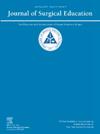双手外科技能训练:怎样才能做好?
IF 2.1
3区 医学
Q1 EDUCATION, SCIENTIFIC DISCIPLINES
引用次数: 0
摘要
目的提高双手灵巧手术在复杂手术中的效率和准确性。然而,它们与外科教育的结合仍然有限。本研究旨在评估非优势手外科训练的可行性和有效性,以及对初级医学生技能习得和信心的影响。设计一项随机对照试验(RCT)。参与者参加了结构化的缝合研讨会,包括示范和指导他们用指定的手(惯用手或非惯用手)动手练习。研讨会在一所大学医学院举行,由左右手外科住院医师领导。研究对象:具有最少缝合经验的一、二年级医学生随机分为两组:NDom(非惯用手训练)和Dom(惯用手训练)。手术技能表现在研讨会前和研讨会后使用改进的评估标准进行评估。通过问卷调查评估对双手手术训练的信心水平和认知。结果共有43名参与者完成了研究(NDom: n = 25;Dom: n = 18)。两组手术技巧均有显著改善(NDom: 1.2 ± 1.6-5.4 ± 2.1,p <; 0.001;Dom: 1.8 ± 2.2至5.4 ± 1.3,p <; 0.001),组间技能获得差异无统计学意义(p = 0.292)。值得注意的是,非惯用手训练也提高了惯用手技能(1.4 ± 1.9-5.0 ± 2.4,p <; 0.001)。两组患者对缝合技术及其在手术室应用的信心均显著增加。此外,97.7%的参与者支持将双手训练纳入外科教育。结论双手灵巧手术训练是可行的,能提高双手的手术技能。训练非优势手不仅可以提高非优势手的灵活性,而且可以加强优势手的技能。考虑到参与者的高水平支持,将非优势手训练纳入早期医学课程可以优化手术的熟练程度和效率。需要进一步的研究来评估长期结果。本文章由计算机程序翻译,如有差异,请以英文原文为准。
Ambidextrous Surgical Skills Training: What is Left to Do it Right?
Objective
Ambidextrous surgical skills may enhance efficiency and precision during complex procedures. However, their integration into surgical education remains limited. This study evaluates the feasibility and effectiveness of nondominant hand surgical training and its impact on skill acquisition and confidence among junior medical students.
Design
A pilot randomized controlled trial (RCT) was conducted.
Setting
Participants attended structured suturing workshops involving demonstrations and supervised hands-on practice with their assigned hand (dominant or nondominant). Workshops were held at a university medical school, led by right- and left-handed surgical residents.
Participants
First- and second-year medical students with minimal suturing experience were randomized into 2 groups: NDom (nondominant hand training) and Dom (dominant hand training). Surgical skill performance was assessed pre- and postworkshop using a modified assessment rubric. Confidence levels and perceptions regarding ambidextrous surgical training were evaluated through questionnaires.
Results
A total of 43 participants completed the study (NDom: n = 25; Dom: n = 18). Both groups demonstrated significant improvement in surgical skills (NDom: 1.2 ± 1.6-5.4 ± 2.1, p < 0.001; Dom: 1.8 ± 2.2 to 5.4 ± 1.3, p < 0.001), with no significant difference in skill acquisition between groups (p = 0.292). Notably, nondominant hand training also improved dominant hand skills (1.4 ± 1.9-5.0 ± 2.4, p < 0.001). Confidence in suturing skills and their application in the operating room increased significantly across both groups. Additionally, 97.7% of participants supported incorporating ambidextrous training into surgical education.
Conclusions
Ambidextrous surgical training is feasible and enhances surgical skills in both hands. Training the nondominant hand not only improves its dexterity but also strengthens dominant hand skills. Given the high level of participant support, integrating nondominant hand training into early medical curricula may optimize surgical proficiency and efficiency. Further research is needed to assess long-term outcomes.
求助全文
通过发布文献求助,成功后即可免费获取论文全文。
去求助
来源期刊

Journal of Surgical Education
EDUCATION, SCIENTIFIC DISCIPLINES-SURGERY
CiteScore
5.60
自引率
10.30%
发文量
261
审稿时长
48 days
期刊介绍:
The Journal of Surgical Education (JSE) is dedicated to advancing the field of surgical education through original research. The journal publishes research articles in all surgical disciplines on topics relative to the education of surgical students, residents, and fellows, as well as practicing surgeons. Our readers look to JSE for timely, innovative research findings from the international surgical education community. As the official journal of the Association of Program Directors in Surgery (APDS), JSE publishes the proceedings of the annual APDS meeting held during Surgery Education Week.
 求助内容:
求助内容: 应助结果提醒方式:
应助结果提醒方式:


